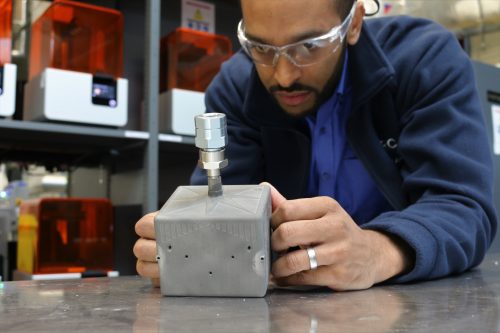Engineers collaborate on out of this world new project

A lightweight fuel tank for small-scale satellites has been developed by engineers at the University of Sheffield Advanced Manufacturing Research Centre (AMRC).
It is part of a pioneering UK Space Agency-funded programme.
Current nanosatellite and microsatellite propellant storage systems either use volume-inefficient but structurally strong cylindrical and spherical tanks.
This means there is much interest in the development of fuel tanks, currently one of the heaviest components of a propulsion system.
AMRC engineers successfully reduced the weight of the tank by over 25%, combined with an almost three-fold increase in fuel capacity over conventional spheroidal storage tanks. This could have a significant impact on satellite launch costs.
Abdul Haque, technical lead in metal additive manufacturing at the AMRC, said: “Developing competitive propulsion solutions for small satellites is a game changer for UK space capability.
“The MiniTANK project lays the groundwork for adding a key miniaturised, low-cost propulsion technology to the UK’s portfolio.”
MiniTANK is a joint effort involving the AMRC and SME technology company Added Value Solutions (AVS) UK to develop a propellant storage system for a nanosatellite that maximises internal volume whilst minimising mass.
Backed by the UK Space Agency’s Pathfinder programme, AMRC researchers have produced a lightweight, high-strength fuel tank for a Cube Satellite (CubeSat for short).
MiniTANK has given the AMRC a foothold in the UK space industry and provides a significant new offering to current and future industrial partners.
Haque said MiniTANK has demonstrated that metal additive manufacturing (AM) is an alternative route for the manufacture of complex fuel tank designs.
“The final AM fuel tank mass was 360 g which was a 28% decrease in weight when compared to the original dry mass of 500 g for a conventional tank,” he said.
“We were able to demonstrate the successful application of AM to achieve performance benefits of a component, the geometry of which is not possible to produce through conventional manufacturing methods.
“We printed the fuel tank out of titanium because it allows us to create a lightweight structure as its specific strength is high compared to other alloys.
“The original cuboidal tank, without any mass optimisation via 3D printing techniques, was around 500 g and we managed to redesign that cuboidal tank into a highly mass optimised tank. Even with internal stiffening structures the final weight came out at 360 g.
“For space, although we’re talking a matter of grams, such a weight saving is hugely significant.
“If you can shave one kilogram off your launch load, it can be potentially £7,000 to £15,000 in terms of cost-saving off the launch.”






